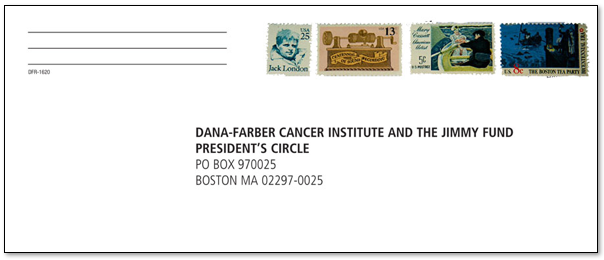It’s easy to get so caught up in the creativity of a direct mail pack that you forget one of the most fundamental facts about it:
It’s a piece of mail that goes through the postal system.
And that means you have choices about the type of postage you use — both outbound and inbound.
In the US, we have two postage rates with a whole lot of ways to deliver each:
- Nonprofit rate, which we can send with a stamp, printed indicia, or metered postage
- First class, which can also be sent different ways.

The cost for both rates varies, depending on how much you cooperate with the postal service’s automation standards.
Here’s a surprise: Recent testing has shown that the rate and type of postage you use to send direct mail has little impact on response.
That means when you’re choosing postage, you are deciding on two factors:
- Cost. Nonprofit rate starts as low as 10¢; a stamped letter is 49¢.
- Timing. First class mail usually gets delivered more quickly than nonprofit rate mail.
In real life, this means you can use nonprofit rate postage any time, even with higher-end donors. Unless you want them to get the mail sooner. Also, we know that variety is good for any donor’s direct mail diet, so using first class postage for your upper donors is probably worth doing.
Another of those you-can-go-either-way postage decisions is what kind of return envelope you use:
- Business Reply Envelope (BRE). The donor can send it back without postage; the postal service bills you for a first-class letter plus a little more.
- Courtesy Reply Envelope (CRE). The donor has to add a stamp to mail it.
(I’m describing how it works in the US; most countries have something similar.)
It used to be that BREs won nearly every test. Not anymore, at least in my experience. Now, BREs and CREs perform about the same. Here’s the odd thing about testing this: If you always use one type of return envelope, and then you test the other type against your usual, the test does better. That is, variety and change are good for a response!
So far, I’ve been telling you that your postage decisions don’t make much of a difference for direct mail results. But there’s one approach I know that makes a big difference: Adding real first-class stamps to the return envelope.
By putting first-class stamps on the return envelope, you will increase response to your direct mail. Better yet, put several stamps of different denominations, adding up to first-class postage. Like this:

This is an expensive thing to do, adding 49¢ to the cost of the direct mail pack. For upper-end donors, it’s a no-brainer. The increased response, coupled with the high gifts they give makes the cost an easy decision. But for the rest of your donors, that cost outweighs the improvement in response.
In my experience, the dividing line between donors it’s worth spending the extra stamps on and those for whom it’s not worth the cost is at $100. It pencils out for donors who give $100 or more in a year, but not for those who give less.
If your experience with postage is different from mine, I’d love to hear about it! If you are in a country with very different postal regulations or conditions that cause you to do things differently, let me know.
How to use postage to maximum impact in direct mail fundraising is just one of the things we’ll look at in my upcoming course, 7 Steps To Creating Record-Smashing Direct Mail. Click here to sign up for The Fundraisingology Lab and get instant access!











2 Comments. Leave new
Do you have any A/B test results for reply envelopes with live stamps vs indicias?
I can’t share specifics, but top-line results are that live stamps on reply envelopes meaningfully improve response rates. But at a rather high cost (55¢ added to the cost per piece mailed), so it’s a good tactic for donors at $100+ but an iffy one for donors below that level.